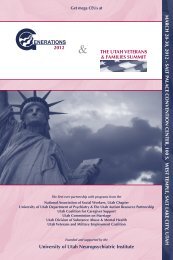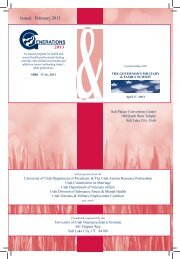The Utah Marriage Handbook - Stronger Marriage
The Utah Marriage Handbook - Stronger Marriage
The Utah Marriage Handbook - Stronger Marriage
You also want an ePaper? Increase the reach of your titles
YUMPU automatically turns print PDFs into web optimized ePapers that Google loves.
Remarriages<br />
Myths & Realities<br />
About 50 percent of all marriages in a year are<br />
remarriages for one or both spouses. Remarriages<br />
and marriages that form stepfamilies (one or<br />
both spouses have children from a previous<br />
relationship) are more complex from the start.<br />
It’s vital that couples forming stepfamilies learn<br />
some specific information about how to build<br />
healthy stepfamilies.<br />
Take the following quiz, and see if you can identify<br />
what is reality, or true, and what is a myth, or false.<br />
1. Attachment between stepparent and stepchildren needs to occur quickly.<br />
2. Children ages 9 to 15 usually have the most difficult time adjusting to a<br />
new stepfamily.<br />
3. Children of divorce and remarriage are forever damaged.<br />
4. <strong>The</strong> stories and myths about wicked stepmothers do not affect today’s<br />
stepfamilies.<br />
5. It is not unusual for a stepfamily to take at least 4 years or more to feel like<br />
a solid family unit.<br />
6. It helps stepfamily adjustment if the nonresidential parent withdraws.<br />
7. Living in a stepfamily formed after a parent dies is easier than living in a<br />
stepfamily formed after a divorce.<br />
8. Part-time stepparenting is easier than full-time stepparenting.<br />
9. A strong couple relationship is an important part of forming a strong stepfamily.<br />
10. A stepparent living with a stepchild has the same legal rights as the<br />
biological parent.<br />
Answers<br />
1. False: More than likely, attachment between<br />
stepparent and stepchildren won’t happen right<br />
away. It takes time, often years, for family members<br />
to get used to, accept, and adapt to different family<br />
histories, rules, routines, and individual habits, attitudes,<br />
values, and rituals. <strong>The</strong> more new relationships to<br />
be formed, the more time it will take. Keep the<br />
following in mind.<br />
• <strong>The</strong> stepparent should not expect to take a parental<br />
or disciplinarian role with stepchildren in the<br />
beginning years.<br />
Special Topics / Remarriages<br />
True False<br />
• <strong>The</strong> biological parent should not expect the<br />
stepparent to feel the way he or she does about<br />
a biological child.<br />
• In general, the older the children the longer the<br />
process of adjustment.<br />
2. True: Older children have the most history<br />
with biological parents and typically have the<br />
following characteristics, making it more difficult<br />
for them to adjust to a stepfamily.<br />
• Developmentally, they are very self-focused and<br />
may think you’ve messed up their lives with all<br />
these changes.<br />
Myths & Realities • 31




